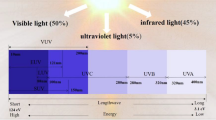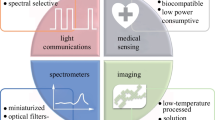Abstract
Tunneling heterostructures are emerging as a versatile architecture for photodetection due to their advanced optical sensitivity, tailorable detection band, and well-balanced photoelectric performances. However, the existing tunneling heterostructures are mainly operated in the visible wavelengths and have been rarely investigated for the near-infrared detection. Herein, we report the design and realization of a novel broken-gap tunneling heterostructure by combining WSe2 and Bi2Se3, which is able to realize the simultaneous visible and near-infrared detection because of the complementary bandgaps of WSe2 and Bi2Se3 (1.46 and 0.3 eV, respectively). Thanks to the realigned band structure, the heterostructure shows an ultralow dark current below picoampere and a high tunneling-dominated photocurrent. The photodetector based on our tunneling heterostructure exhibits a superior specific detectivity of 7.9×1012 Jones for a visible incident of 532 nm and 2.2×1010 Jones for a 1456 nm near-infrared illumination. Our study demonstrates a new band structure engineering avenue for the construction of van der Waals tunneling heterostructures for high-performance wide band photodetection.
摘要
隧穿异质结因其先进的光学灵敏度、可定制的探测范围以及均衡的光电性能而正逐渐成为一种光电探测的通用体系结构. 但是, 现有的隧穿异质结主要在可见光波段工作, 很少能实现近红外光探测. 本文利用具有互补带隙的WSe2和Bi2Se3(1.46和0.3 eV)设计了一种能同时实现高性能可见和近红外光探测的新型裂隙隧穿异质结. 由于能带结构的重新排列, WSe2/Bi2Se3异质结构展现出了低于pA量级的暗电流和以隧穿为主的光电流. 我们设计的隧穿异质结对532 nm可见光和1456 nm近红外光的比探测度高达7.9×1012和2.2×1010 Jones. 本研究为构建用于高性能宽带光探测的范德瓦尔斯隧穿异质结构提供了一种新的带结构工程途径.
Similar content being viewed by others
References
Geim AK, Grigorieva IV. van der Waals heterostructures. Nature, 2013, 499: 419–425
Liu Y, Weiss NO, Duan X, et al. Van der Waals heterostructures and devices. Nat Rev Mater, 2016, 1: 16042
Koppens FHL, Mueller T, Avouris P, et al. Photodetectors based on graphene, other two-dimensional materials and hybrid systems. Nat Nanotech, 2014, 9: 780–793
Novoselov KS, Mishchenko A, Carvalho A, et al. 2D materials and van der Waals heterostructures. Science, 2016, 353: aac9439
Xia F, Wang H, Xiao D, et al. Two-dimensional material nanophotonics. Nat Photon, 2014, 8: 899–907
Lee CH, Lee GH, van der Zande AM, et al. Atomically thin p-n junctions with van der Waals heterointerfaces. Nat Nanotech, 2014, 9: 676–681
Wang F, Wang Z, Xu K, et al. Tunable GaTe-MoS2 van der Waals p-n junctions with novel optoelectronic performance. Nano Lett, 2015, 15: 7558–7566
Wang T, Andrews K, Bowman A, et al. High-performance WSe2 phototransistors with 2D/2D ohmic contacts. Nano Lett, 2018, 18: 2766–2771
Li L, Han W, Pi L, et al. Emerging in-plane anisotropic two-dimensional materials. InfoMat, 2019, 1: 54–73
Xie C, Mak C, Tao X, et al. Photodetectors based on two-dimensional layered materials beyond graphene. Adv Funct Mater, 2017, 27: 1603886
Long M, Wang Y, Wang P, et al. Palladium diselenide long-wavelength infrared photodetector with high sensitivity and stability. ACS Nano, 2019, 13: acsnano.8b09476
Wang Y, Liu E, Gao A, et al. Negative photoconductance in van der Waals heterostructure-based floating gate phototransistor. ACS Nano, 2018, 12: 9513–9520
Wang RY, Zhou FY, Lv L, et al. Modulation of the anisotropic electronic properties in ReS2via ferroelectronic film. CCS Chem, 2019, 1: 268–277
Zhou X, Zhou N, Li C, et al. Vertical heterostructures based on SnSe2/MoS2 for high performance photodetectors. 2D Mater, 2017, 4: 025048
Ye L, Li H, Chen Z, et al. Near-infrared photodetector based on MoS2/black phosphorus heterojunction. ACS Photonics, 2016, 3: 692–699
Wen Y, Yin L, He P, et al. Integrated high-performance infrared phototransistor arrays composed of nonlayered PbS-MoS2 heterostructures with edge contacts. Nano Lett, 2016, 16: 6437–6444
Cao R, Wang HD, Guo ZN, et al. Black phosphorous/indium selenide photoconductive detector for visible and near-infrared light with high sensitivity. Adv Opt Mater, 2019, 7: 1900020
Chu D, Lee YH, Kim EK. Selective control of electron and hole tunneling in 2D assembly. Sci Adv, 2017, 3: e1602726
Vu QA, Lee JH, Nguyen VL, et al. Tuning carrier tunneling in van der Waals heterostructures for ultrahigh detectivity. Nano Lett, 2017, 17: 453–459
Zhou X, Hu X, Zhou S, et al. Tunneling diode based on WSe2/SnS2 heterostructure incorporating high detectivity and responsivity. Adv Mater, 2018, 30: 1703286
Liu X, Qu D, Li HM, et al. Modulation of quantum tunneling via a vertical two-dimensional black phosphorus and molybdenum disulfide p-n junction. ACS Nano, 2017, 11: 9143–9150
Wu F, Xia H, Sun H, et al. AsP/InSe van der Waals tunneling heterojunctions with ultrahigh reverse rectification ratio and high photosensitivity. Adv Funct Mater, 2019, 29: 1900314
Li H, Cao J, Zheng W, et al. Controlled synthesis of topological insulator nanoplate arrays on mica. J Am Chem Soc, 2012, 134: 6132–6135
Zheng W, Xie T, Zhou Y, et al. Patterning two-dimensional chalcogenide crystals of Bi2Se3 and In2Se3 and efficient photodetectors. Nat Commun, 2015, 6: 6972
Wang F, Li L, Huang W, et al. Submillimeter 2D Bi2Se3 flakes toward high-performance infrared photodetection at optical communication wavelength. Adv Funct Mater, 2018, 28: 1802707
Chuang CHM, Brown PR, Bulović V, et al. Improved performance and stability in quantum dot solar cells through band alignment engineering. Nat Mater, 2014, 13: 796–801
Wu H, Kang Z, Zhang Z, et al. Interfacial charge behavior modulation in perovskite quantum dot-monolayer MoS2 0D–2D mixed-dimensional van der Waals heterostructures. Adv Funct Mater, 2018, 28: 1802015
Zhang H, Liu CX, Qi XL, et al. Topological insulators in Bi2Se3, Bi2Te3 and Sb2Te3 with a single Dirac cone on the surface. Nat Phys, 2009, 5: 438–442
Bianchi M, Guan D, Bao S, et al. Coexistence of the topological state and a two-dimensional electron gas on the surface of Bi2Se3. Nat Commun, 2010, 1: 128
Peng H, Dang W, Cao J, et al. Topological insulator nanostructures for near-infrared transparent flexible electrodes. Nat Chem, 2012, 4: 281–286
Furchi MM, Pospischil A, Libisch F, et al. Photovoltaic effect in an electrically tunable van der Waals heterojunction. Nano Lett, 2014, 14: 4785–4791
Ji J, Choi JH. Layer-number-dependent electronic and optoelectronic properties of 2D WSe2-organic hybrid heterojunction. Adv Mater Interfaces, 2019, 6: 1900637
Doan MH, Jin Y, Adhikari S, et al. Charge Transport in MoS2/WSe2 van der Waals heterostructure with tunable inversion layer. ACS Nano, 2017, 11: 3832–3840
Lee I, Rathi S, Lim D, et al. Gate-tunable hole and electron carrier transport in atomically thin dual-channel WSe2/MoS2 heterostructure for ambipolar field-effect transistors. Adv Mater, 2016, 28: 9519–9525
Cheng R, Li D, Zhou H, et al. Electroluminescence and photocurrent generation from atomically sharp WSe2/MoS2 heterojunction p-n diodes. Nano Lett, 2014, 14: 5590–5597
Yang T, Zheng B, Wang Z, et al. Van der Waals epitaxial growth and optoelectronics of large-scale WSe2/SnS2 vertical bilayer p-n junctions. Nat Commun, 2017, 8: 1906
Ramasubramaniam A. Large excitonic effects in monolayers of molybdenum and tungsten dichalcogenides. Phys Rev B, 2012, 86: 115409
Yu Y, Hu S, Su L, et al. Equally efficient interlayer exciton relaxation and improved absorption in epitaxial and nonepitaxial MoS2/WS2 heterostructures. Nano Lett, 2015, 15: 486–491
Chiu MH, Zhang C, Shiu HW, et al. Determination of band alignment in the single-layer MoS2/WSe2 heterojunction. Nat Commun, 2015, 6: 7666
Wu H, Si H, Zhang Z, et al. All-inorganic perovskite quantum dotmonolayer MoS2 mixed-dimensional van der Waals heterostructure for ultrasensitive photodetector. Adv Sci, 2018, 5: 1801219
Huang Y, Zhuge F, Hou J, et al. Van der Waals coupled organic molecules with monolayer MoS2 for fast response photodetectors with gate-tunable responsivity. ACS Nano, 2018, 12: 4062–4073
Nourbakhsh A, Zubair A, Dresselhaus MS, et al. Transport properties of a MoS2/WSe2 heterojunction transistor and its potential for application. Nano Lett, 2016, 16: 1359–1366
Srivastava PK, Hassan Y, Gebredingle Y, et al. Multifunctional van der Waals broken-gap heterojunction. Small, 2019, 15: 1804885
Das S, Prakash A, Salazar R, et al. Toward low-power electronics: tunneling phenomena in transition metal dichalcogenides. ACS Nano, 2014, 8: 1681–1689
Fan S, Vu QA, Lee S, et al. Tunable negative differential resistance in van der Waals heterostructures at room temperature by tailoring the interface. ACS Nano, 2019, 13: 8193–8201
Fan S, Yun SJ, Yu WJ, et al. Tailoring quantum tunneling in a vanadium-doped WSe2/SnSe2 heterostructure. Adv Sci, 2020, 7: 1902751
Guo Z, Chen Y, Zhang H, et al. Independent band modulation in 2D van der Waals heterostructures via a novel device architecture. Adv Sci, 2018, 5: 1800237
Wang X, Wang P, Wang J, et al. Ultrasensitive and broadband MoS2 photodetector driven by ferroelectrics. Adv Mater, 2015, 27: 6575–6581
Long M, Gao A, Wang P, et al. Room temperature high-detectivity mid-infrared photodetectors based on black arsenic phosphorus. Sci Adv, 2017, 3: e1700589
Liu H, Li D, Ma C, et al. Van der Waals epitaxial growth of vertically stacked Sb2Te3/MoS2 p-n heterojunctions for high performance optoelectronics. Nano Energy, 2019, 59: 66–74
Yao J, Zheng Z, Yang G. Layered-material WS2/topological insulator Bi2Te3 heterostructure photodetector with ultrahigh responsivity in the range from 370 to 1550 nm. J Mater Chem C, 2016, 4: 7831–7840
Liu H, Zhu X, Sun X, et al. Self-powered broad-band photodetectors based on vertically stacked WSe2/Bi2Te3 p-n heterojunctions. ACS Nano, 2019, 13: 13573–13580
Acknowledgements
This work was supported by the National Nature Science Foundation of China (21825103 and 51727809), Hubei Provincial Natural Science Foundation of China (2019CFA002) and the Fundamental Research Funds for the Central Universities (2019kfyXMBZ018). The authors thank the Analytical and Testing Centre of Huazhong University of Science and Technology.
Author information
Authors and Affiliations
Contributions
Wang F and Huang Y fabricated the devices. Zhang Y and Zhang Q did the AFM and Raman measurements, respectively. Wang F performed the characterization and wrote the manuscript. Zhai T supervised the project. Wang F, Luo P, Yuan L and Zhai T discussed the manuscript and made the revision.
Corresponding author
Additional information
Conflict of interest
The authors declare that they have no conflict of interest.
Fakun Wang received his BSc degree in mineral processing engineering from Central South University in 2016. He is studying for his PhD degree at Huazhong University and Technology under the supervision of professor Tianyou Zhai. His work focuses on the controllable synthesis of low-dimensional inorganic materials, and their promising applications in optoelectronics.
Tianyou Zhai received his BSc degree in chemistry from Zhengzhou University in 2003, and PhD degree in physical chemistry from the Institute of Chemistry, Chinese Academy of Sciences (ICCAS) under the supervision of Prof. Jiannian Yao in 2008. Afterwards he joined the National Institute for Materials Science (NIMS, Japan) as a postdoctoral fellow of Japan Society for the Promotion of Science (JSPS) in Prof. Yoshio Bando’s group and then as a researcher of the International Center for Young Scientists (ICYS) within NIMS. Currently, he is a chief professor of the School of Materials Science and Engineering, Huazhong University of Science and Technology. His research interests include the controlled synthesis and exploration of fundamental physical properties of inorganic functional nanomaterials, as well as their promising applications in energy science, electronics and optoelectronics.
Supplementary Information for
Rights and permissions
About this article
Cite this article
Wang, F., Luo, P., Zhang, Y. et al. Band structure engineered tunneling heterostructures for high-performance visible and near-infrared photodetection. Sci. China Mater. 63, 1537–1547 (2020). https://doi.org/10.1007/s40843-020-1353-3
Received:
Accepted:
Published:
Issue Date:
DOI: https://doi.org/10.1007/s40843-020-1353-3




